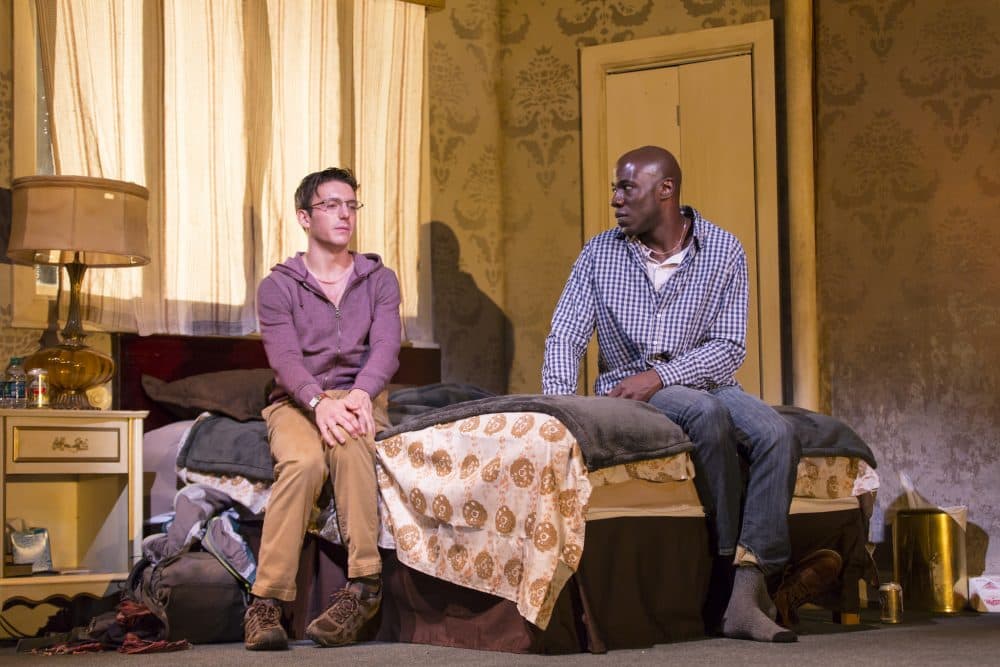Advertisement
Review
'A Guide For The Homesick' Could Leave You With Spiritual Sunburn

There’s a reason Ken Urban’s new play “A Guide for the Homesick” has a short run-time of 75 minutes: A work this intense, this radiant and searing, could leave you with spiritual sunburn.
The show (continuing through Nov. 4 in the Huntington Theatre Company’s world premiere at the Boston Center for the Arts) sizzles with restlessness and erotic energy from the very first moments. It’s January in Amsterdam; a cold downpour makes the night inhospitable. Teddy (McKinley Belcher III), who is on vacation, brings Jeremy (Samuel H. Levine) back to his shabby hotel room after Jeremy missed his connection from Uganda back to the United States. They’re both jittery, anxious for some company and troubled by things they’re unwilling to disclose. Teddy gives voice to this dynamic straight away, recounting the thought he had when he first saw Jeremy in the bar: “This guy — he’s in the same place you are, Teddy.”
As it happens, he’s also from the same place. Both Teddy and Jeremy grew up around Boston, though they have distinctly different backgrounds. (“Roxbury is a little rougher than Newton,” Teddy jibes, in one of the show’s rich, dead-on laugh lines.) On the surface, their dilemmas seem to have little in common. The Harvard-educated Jeremy is a nurse whose year of service in Uganda has been cut short thanks to political instability and a threat of violence, while Teddy’s trip to Amsterdam — taken with a friend named Eddie — has gone wrong. But as the night goes on and the new friends drink, pick at one another and slowly start to open up, it becomes apparent that their misery springs from similar sources.

Teddy’s traveling companion, Eddie (played in flashback by Levine), has been suffering from depression; it could be a mater of neurochemistry, or it could be pre-wedding anxiety. After making promises and reassurances to Eddie’s fiancée, Teddy brought his friend to Europe in hopes that the trip would do him good. But Eddie, in the grip of a manic episode, left four days ago, and hasn’t been heard from since. Now his fiancée tries to phone every few minutes, but Teddy, fearful of what news she might impart, refuses to answer.
Jeremy is also gripped by guilt and fear. While in Uganda he got to know a gay man named Nicholas (played in flashback by Belcher). The two became close, even emotionally intimate, but things remained platonic. (Even if Jeremy were gay, Nicholas was exclusive with his boyfriend.) Then American evangelicals brought a message of homophobic hatred to Uganda, and the political situation quickly turned lethal, with gay men being identified, lists of names compiled and mobs burning victims alive in the streets. Jeremy, in a mix of panic and blind optimism, miscalculated the risks for Nicholas.
Belcher and Levine, under the direction of Colman Domingo, pull off whip-fast changes of characterization, fluidly and completely switching between dual roles for the flashback scenes. At the same time, the lighting (by Russell H. Champa) and sound design (by Lindsay Jones) also transforms, with the same razor-edged precision; the cool blue mood of Amsterdam, for instance, is suddenly a hot, orange afternoon in Uganda. The transitions take place so swiftly you don’t even question them, and the fluency of the actors ensure that even when we snap back to the present for a quick line or two of dialogue the characters remain thoroughly differentiated in speech and manner. (Kara Harmon’s costuming doesn’t change, but it almost seems to, so complete are the actors’ transformations in terms of movement and bearing.)
Urban’s script burns with outrage for the way real-life American religious meddling incited homophobic violence and legislative oppression in African nations like Uganda. (Similar interference has helped push Russia and other eastern nations to their current levels of anti-gay persecution.) For a scant moment here and there, Urban tries to shoehorn too much about this into the script; a tense scene between Jeremy and a terrified Nicholas, describes an ugly episode at church, lapses momentarily into a digression over the way anti-gay religious attitudes and laws that persecute LGBT people constitute one more example of Western colonialism. That’s a valid point, but its inclusion puts the brakes on the scene’s emotional momentum. What’s more, it feels forced; dialogue that is otherwise natural is suddenly, jarringly preachy.

Similarly, Teddy and Jeremy’s early exchanges are marred by an overreaction from Jeremy, who rails at Teddy for imposing preconceived notions on him based on his youthful appearance and his gay-seeming affect. Jeremy insists that he’s neither a “kid” nor gay, and threatens to leave — only to stay, of course. And while the idea that someone can set off a person’s gaydar and still be straight (or, alternatively, insist he’s straight while struggling with truths he’s not ready to face) is worth investigating, the way it’s done here feels trite, with Jeremy’s histrionics coming across as an attempt to ratchet up the drama. It’s unnecessary; the actors bring such palpable energy to their interactions that they effortlessly hold our attention.
By and large, however, the script trusts the actors, directors and designers to sustain and lend loft to the play’s emotional mysteries, and the story’s pacing is flawless. Degree by degree, Urban ushers us through a nautilus shell of self-delusion and self-justification to a core of absolute terror — a terror that’s less about our own safety than of forgetting our better natures, making uncorrectable mistakes and hurting the people we love.
“A Guide for the Homesick” continues through Nov. 4 at the Boston Center for the Arts.